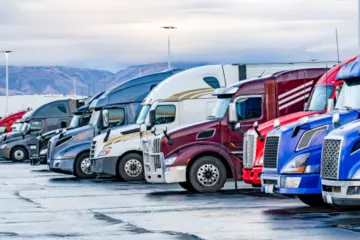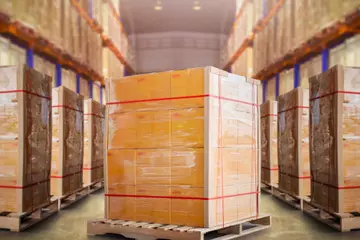America’s railroad system
From the West Coast to the East Coast, America runs one of the safest, most extensive and reliable railroad systems in the world. The 140,000-mile network is owned and operated by 600 freight rail lines, including seven Class I railroad companies. Together, these rail lines earned nearly $74 billion in revenue in 2017 — Class I railroads earned $70 billion of that total. From agricultural products to construction materials and household goods to clothing and shoes, America’s rail system is an efficient way to move freight across the United States. Find out more about the country’s major rail companies, how many track miles they operate and the type of freight they carry.
Class I railroads
Seven Class I railroads operate in 44 states, the District of Columbia, and parts of Canada and Mexico. A Class I railroad company is currently defined as rail lines with a 2016 revenue of at least $447.6 million. Together, they account for 69 percent of all track mileage and employ 90 percent of U.S. railroad workers. The following list provides additional information on each Class I network — they are in order from largest to smallest in terms of track miles:
- Union Pacific Railroad — Headquartered in Omaha, Nebraska
Founded in 1862, Union Pacific (UP) has been providing train transportation for 156 years. It’s the largest railroad in North America, operating 51,683 miles in 23 states. The company employs 43,500 people, owns and leases 8,573 locomotives and commonly ships commodities like coal, chemicals, food and forest products, automobiles and agricultural products. - BNSF Railway — Headquartered in Fort Worth, Texas
Burlington Northern and Santa Fe Railway, most often referred to as BNSF, was founded in 1849 and today is the second-largest American rail company. Spanning across 28 states and three Canadian provinces, BNSF has 32,500 miles of tracks, 8,000 locomotives and employs more than 41,000 people. The company also is the largest intermodal railway in North America, handling more than 5 million intermodal shipments in 2017. The most commonly shipped goods include grains, raw materials, electronics, clothing and low-sulfur coal. - CSX Transportation — Headquartered in Jacksonville, Florida
Since 1827, CSX transportation has helped move goods across America. The company runs a 21,000-mile system in 23 states, the District of Columbia, and the Canadian provinces of Ontario and Quebec. Its network reaches nearly two-thirds of the nation’s population — connecting to more than 230 short line and regional railroads and over 70 ocean, river and lake ports along the Atlantic and Gulf coasts, the Mississippi River, the Great Lakes and the St. Lawrence Seaway. Today, CSX employees about 25,000 people and provides traditional rail freight services and intermodal shipping. - Canadian National Railway — Headquartered in Montreal, Quebec
Canadian National Railway (CN) began operation in 1918 and is the largest rail network in Canada and the only transcontinental network in North America. Its system spans 19,600 miles of track in 16 U.S. states and eight Canadian provinces, offering rail connections to three coasts. The company has more than 22,000 employees who help serve the markets of automotive, coal, fertilizers, food and beverages, forest products, grain and intermodal. - Norfolk Southern Railway — Headquartered in Norfolk, Virginia
Founded in 1838, Norfolk Southern (NS) is a major transporter of coal, automotive and industrial products. It operates 19,500 miles of rail across 22 states and the District of Columbia, owns and leases 4,155 locomotives and 62,705 freight cars, and employs more than 27,000 people. Norfolk also transports goods from every major East Coast port between New York City and Jacksonville, Florida. - Canadian Pacific Railway — Headquartered in Calgary, Alberta
Canadian Pacific (CP) Railway started operating in 1881. Today, the company owns 15,000 miles of track across 13 states and six provinces. CP plays a critical role in train transport by connecting ports on the Pacific and Atlantic Coasts with major North American distribution centers and every Class I railroad. The major industries it serves include automotive, coal, energy, ethanol, food production, industrial products and intermodal. - Kansas City Southern — Headquartered in Kansas City, Missouri
Established in 1887, Kansas City Southern (KCS) is the smallest of the Class I railroads, operating only 6,000 miles of track in the U.S. and Mexico. KCS is comprised of three railroads — Kansas City Southern Railways Company, Kansas City Southern de Mexico and Panama Canal Railway Company. The system connects central U.S. markets with major industrial cities in Mexico. Commonly shipped commodities are aggregates and minerals, agricultural products, appliances, chemicals, consumer goods, food products and plastics.
Intermodal’s role in rail transportation
Intermodal shipping incorporates more than one mode of transportation (e.g., trains and trucks) to cover more ground in a timely manner. It’s considered the rail industry’s fastest-growing sector, accounting for roughly 23 percent of America’s rail freight revenue. The Association of American Railroads reported record-setting intermodal activity in August 2017, which contributed to the year’s total intermodal traffic increase of 3.9 percent. By using this method of transportation, shippers can experience a reliable, cost-efficient, flexible, safe and environmentally friendly way to transport goods long distance. To learn more, read our blog post on the benefits on intermodal shipping.
Need rail shipping services? Choose ArcBest®
With a strategic advantage in intermodal transportation, ArcBest® combines truck and rail services to ship freight moving distances of 700 miles or more. Through our partnerships with all Class I railroads, we can provide intermodal customers with reduced costs, more access to capacity, transit times similar to over the road transport and increased visibility. For more information, call 800-610-5544 or email customersolutions@arcb.com.







